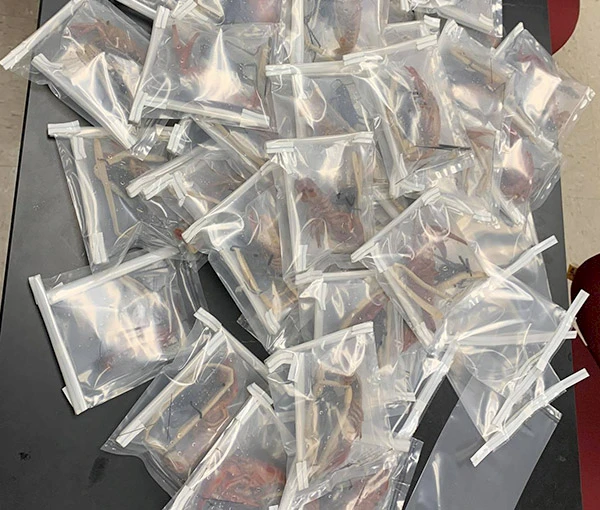Henderson professors overcome online obstacles

Individually-packaged crayfish were mailed to biology students for their lab work.
First in a series
When Henderson State University shifted to remote instruction March 13, most professors and instructors faced an immediate challenge to adapt their lesson plans to an online format.
Classes with labs created additional hurdles, but Dr. James Engman, professor of biology, found a workaround that gave his students the hands-on experience they would otherwise miss.
He packaged the lab contents and mailed them to the individual students.
“I knew that lab would be a challenge. Before the students left, they were asked to take their lab manuals, gloves, and dissection kits home with them.” Engman said. “I mailed out packets to students at the beginning of the shutdown, and these included preserved earthworms, crayfish, and grasshoppers.”
Engman’s online lab presentations are accompanied by lessons he would have given in class, and by YouTube videos showing the dissections in progress.
“The students send me photos of their dissections, pointing out individual structures, and sometimes preparing sheets such as one that has all of the many crayfish appendages on it, labeled with names and functions,” Engman said. “They are doing really well, for the most part.”
Engman said his biggest challenge may be the emotional aspect.
“I love teaching and love my students, and by this time in the semester, we have developed some very good relationships,” he said. “Not being able to see them on a daily basis is difficult for me.
“The other huge challenge is simply dealing with the volume of emails that online teaching requires. Between the students submitting assignments and asking questions, much of what I do everyday is just trying to keep track of who has done what.”
Engman said he has moved to more project-based learning, rather than “relying heavily” on exams.
“One example of a project, which I have used in the past as group work, is to prepare a diagram of a nephron (the functional unit of a kidney) and come up with a set of symbols to represent the processes taking place in each part,” he said. “They cannot use any numbers or letters, so they end up coming up with creative and often hilarious symbols.
“Many students have told me that this was a very fun exercise, and a great way to end up learning things on their own.”
Engman said he can’t pinpoint the “biggest thing” he has learned from this experience.
“I am still definitely learning,” he said. “It’s hard enough to be a biology major under the best of circumstances. The students are dealing with all sorts of issues at home, not the least of which is stress and anxiety, which make it difficult to concentrate and stay motivated.
“They have other issues, as well. There are increased responsibilities, like watching younger siblings and taking care of older family members. There are others, including some family members, who don’t understand the workload that the students are dealing with.”
“By and large, I am very pleased with student performance, participation, attitude, and patience,” Engman said.